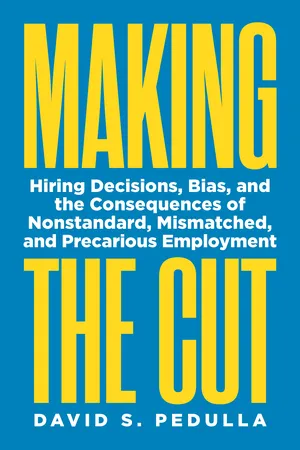1
Hiring in the New Economy
Employment is central to the economic security and well-being of individuals and their families in the United States. Jobs provide wages and benefits. Jobs provide opportunities for skill development and growth. Jobs provide many of the building blocks necessary for other domains of one’s life, such as health, housing, and family. At its core, this book is about the allocation of employment opportunities in the contemporary economy—an economy where millions of workers have experience in positions that are part-time, through temporary help agencies, and well below their skill level. In this environment, how do workers get jobs? How does the hiring process actually work? And, ultimately, who comes out ahead?
Accessing employment opportunities is a complex matching process between employers and workers.1 Employers are looking for the right employees to execute the tasks needed by their companies. Workers are looking for the right jobs. Jobs that provide them with a set of material and subjective rewards, such as wages, benefits, and satisfaction. The underlying mechanics of how the matching of workers and employers actually happens, however, is far from straightforward.2 There is no centralized system to assign workers and employers to one another. There is no single way that workers decide which employers they want to work for. And there is no single criterion on which employers evaluate job applicants.
Understanding how this matching of workers and employers takes place has been a central concern of social scientists for decades.3 Scholars often conceptualize the labor market as a two-sided matching process. The supply side focuses on workers—their education, training, preferences, and behaviors. The demand side focuses on employers—their needs, desires, and evaluative criteria for hiring workers. While understanding both sides of the process is important, this book centers its attention on the demand side of the equation: employers and their decision making.4 A large body of research concentrating on hiring finds that, more than simply prioritizing technical skills and credentials, employers and hiring professionals care about a broad array of other worker characteristics during the hiring process. They want workers who comply with “ideal worker” norms of commitment and competence.5 They want workers with soft skills and the “right” personality.6 They want workers who are a “fit” with the organization’s culture, its workers, and its managers.7
The set of criteria that hiring professionals use to evaluate job applicants lies at the center of this book. Recognizing the changing nature of work and employment in the United States, Making the Cut asks whether the ways that employers evaluate potential employees have kept pace with this shifting economic landscape. As existing scholarship has demonstrated, the underlying organization of work in the United States does not look the same as it did in the middle of the twentieth century, a period when many of our current models of employment relations emerged.8 There has been a decline in manufacturing employment and an increase in service sector employment.9 The occupational structure has become more polarized, with both high- and low-wage job growth outpacing the growth of middle-wage jobs.10 Technological advances, such as the increasing importance of computers and the internet, have reshaped the ways that work takes place.11 Global economic integration has generated new forms of competition.12 And employment relations have also changed. Internal labor markets—where companies promote workers through career ladders at the company—have declined.13 Many organizations now rely on nonstandard and contingent labor too.14 This set of shifts—as well as others—is part of the bundle of changes resulting in what scholars often refer to as the “new economy.”15
Workers’ experiences have been deeply altered by these realities. Feelings of economic insecurity are widespread.16 Individuals and families feel pressed financially, uncertain of how they will survive and thrive.17 And employment relationships—as well as the obligations between workers and employers—have shifted.18 Millions of workers now labor through temporary help agencies, in part-time positions, at jobs below their skill level, and as independent contractors, freelancers, on-call workers, and day laborers.19 At the same time, long-term unemployment and its associated challenges have become commonplace in the labor force, particularly during periods of recession and recovery.20 While the growth in some of these types of alternative employment relationships may be overstated in the public imagination,21 one thing is clear: millions of workers labor in nonstandard, mismatched, and precarious positions.22
Against this backdrop, Making the Cut inspects one key component of the insecurities faced by workers: nonstandard, mismatched, and precarious employment experiences. Specifically, I examine the consequences of part-time work, temporary agency employment, skills underutilization, and long-term unemployment for workers’ employment opportunities. To date, scholars have examined how these positions affect a set of important worker outcomes: wages, benefits, autonomy and control, subjective well-being, job security, and health, to name a few.23 Much less attention, however, has been directed to the consequences of these employment positions for workers’ future opportunities in the labor market, specifically their ability to obtain a new job.
Have hiring professionals and employers updated the ways they evaluate job applicants to align with the current economic structure? If assumptions of an unrealistic and outdated economic landscape remain embedded in hiring professionals’ criteria of evaluation, those assumptions might exacerbate or mitigate inequality during the hiring process. How would a hiring manager evaluate a college graduate with multiple years of managerial experience but who then ended up taking a retail job? What about an administrative assistant who spent a year working through a temporary help a...
